Occupation Racing driver Name Tazio Nuvolari | Role Racing driver Spouse Carolina Perina (m. 1917) | |
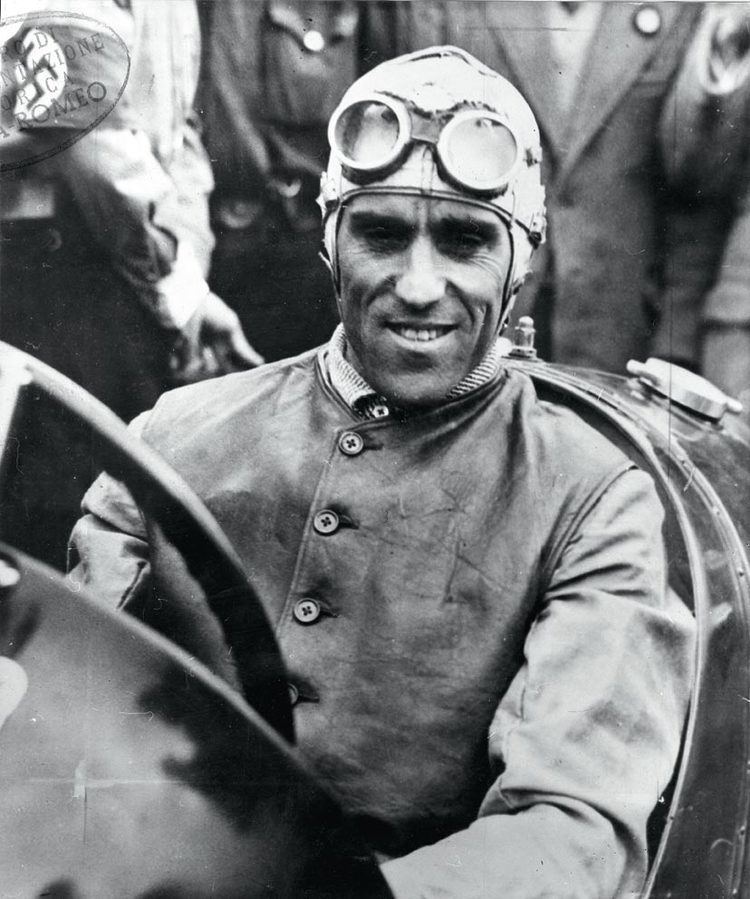 | ||
Children Giorgio NuvolariAlberto Nuvolari Parents Arturo Nuvolari, Elisa Zorzi | ||
Bronze artwork with famous race car driver tazio nuvolari the gallery brummen tv
Tazio Giorgio Nuvolari ([ˈtattsjo ˈdʒordʒo nuvoˈlari]; 16 November 1892 – 11 August 1953) was an Italian racing driver. First he raced motorcycles and then he concentrated on sports cars and single-seaters. Resident in Mantua, he was known as 'Il Mantovano Volante' (The Flying Mantuan) and nicknamed 'Nivola'. His victories—72 major races, 150 in all—included 24 Grands Prix, five Coppa Cianos, two Mille Miglias, two Targa Florios, two RAC Tourist Trophies, a Le Mans 24-hour race, and a European Championship in Grand Prix racing. Ferdinand Porsche called him "the greatest driver of the past, the present, and the future."
Contents
- Bronze artwork with famous race car driver tazio nuvolari the gallery brummen tv
- 1938 italian gran prix won by tazio nuvolari auto union
- Personal and early life
- Motorcycle racing
- 1930 1932 Alfa Corse
- 1933 1937 Scuderia Ferrari and Maserati
- 1938 1939 Auto Union
- Post war racing
- Death and legacy
- Complete European Championship results
- References
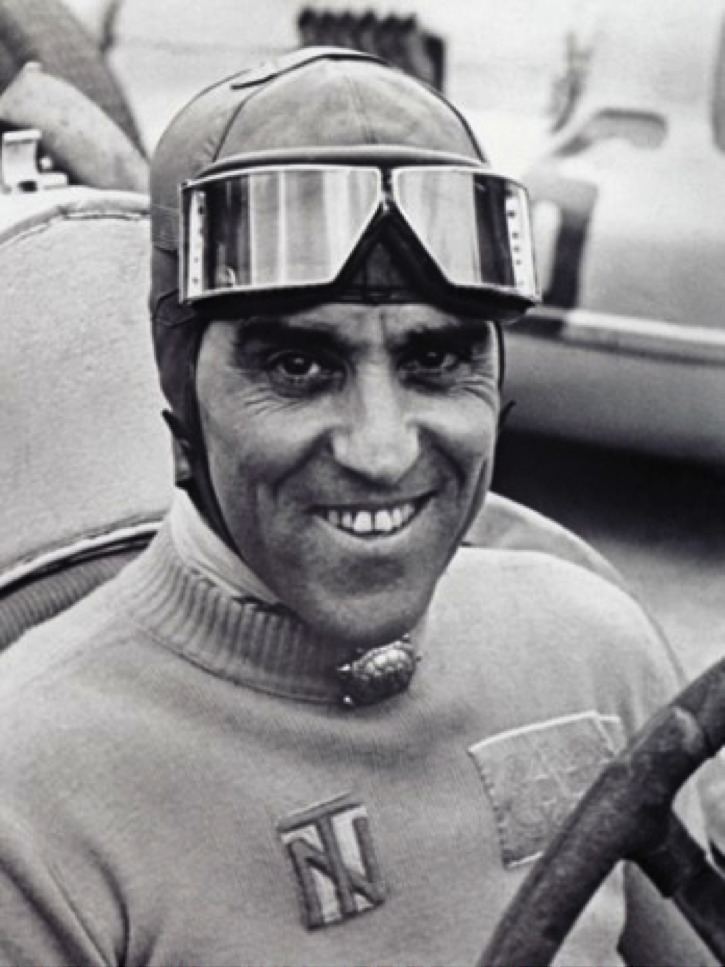
Nuvolari started racing motorcycles in 1920 at the age of 27, winning the 1925 350cc European Championship. Having raced cars as well as motorcycles from 1925 until 1930, he then concentrated on cars, and won the 1932 European Championship with the Alfa Romeo factory team, Alfa Corse.
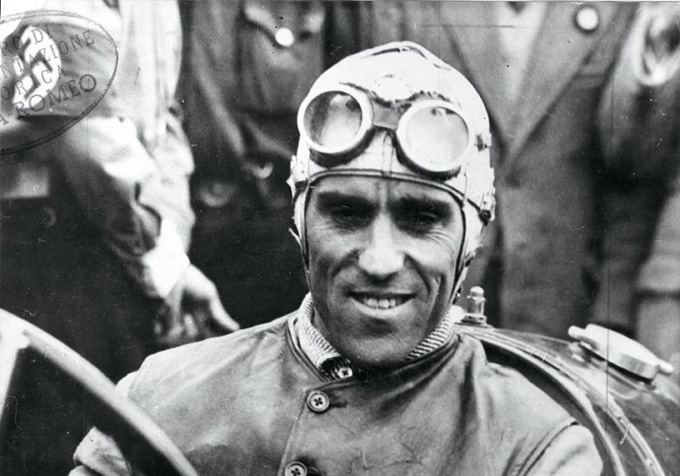
After Alfa Romeo officially withdrew from Grand Prix racing Nuvolari drove for Enzo Ferrari's team, Scuderia Ferrari, who ran the Alfa Romeo cars semi-officially. In 1933 he won Le Mans in an Alfa Romeo as a member of Ferrari's team, and a month later won the Belgian Grand Prix in a works Maserati, having switched teams a week before the race. Mussolini helped persuade Ferrari to take Nuvolari back for 1935, and in that year he won the German Grand Prix in Ferrari's outdated Alfa Romeo, defeating more powerful rivals from Mercedes-Benz and Auto Union. It was the only time a non-German car won a European Championship race from 1935 to 1939.
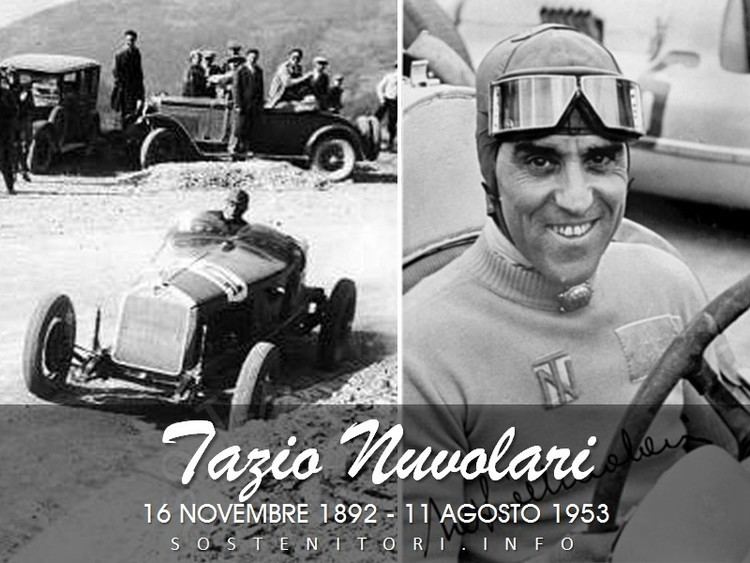
The relationship with Ferrari deteriorated during 1937, and Nuvolari raced an Auto Union in that year's Swiss Grand Prix. He rejoined the Auto Union team for the 1938 season and stayed with them through 1939 until Grand Prix racing was put on hiatus by World War II. The only major European race he never won was the Czechoslovakian Grand Prix.
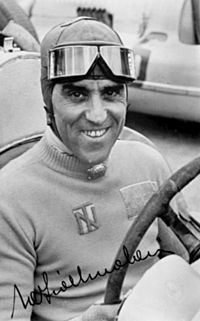
When Nuvolari resumed racing after the war he was 54 and in poor health. In his final appearance in competition, driving a Cisitalia-Abarth Tipo 204A at a Palermo hillclimb on 10 April 1950, he won his class and placed fifth overall. He died in 1953 from a stroke.
1938 italian gran prix won by tazio nuvolari auto union
Personal and early life
Nuvolari was born in Castel d'Ario near Mantua on 16 November 1892 to Arturo Nuvolari and his wife Elisa Zorzi. The family was well acquainted with motor racing as Arturo and his brother Giuseppe were both bicycle racers - Giuseppe was a multiple winner of the Italian national championship and was particularly admired by a young Tazio.
Nuvolari was married to Carolina Perina, and together they had two children: Giorgio (born 4 September 1918), who died in 1937 aged 19 from myocarditis, and Alberto, who died in 1946 aged 18 from nephritis.
Motorcycle racing
Nuvolari obtained his license for motorcycle racing in 1915 at the age of 23. He served in the Italian army as an ambulance driver in World War I, and in 1920 took part in his first motorcycle race at the Circuito Internazionale Motoristico in Cremona but did not finish. He also raced cars, winning the Coppa Verona reliability trial in 1921.
In 1925 he became the 350 cc European Motorcycling champion by winning the European Grand Prix. At the time, the European Grand Prix was considered the most important race of the motorcycling season and the winners in each category were designated European Champions. He won the Nations Grand Prix four times between 1925 and 1928, and the Lario Circuit race five times between 1925 and 1929, all in the 350 cc class on a Bianchi motorcycle.
It was also in 1925 that Alfa Romeo, seeking a driver to replace Antonio Ascari, who had been killed in the French Grand Prix in July, tested Nuvolari in their Grand Prix car with a view to running him in the Italian Grand Prix in September. He crashed when the gearbox seized, and severely lacerated his back. He was not picked for the team. Six days later, in bandages, with a cushion strapped to his stomach, and lifted onto his motorcycle by Bianchi mechanics for a push-start, he won the rain-soaked Nations Grand Prix at Monza.
1930-1932: Alfa Corse
1930
In 1930, Nuvolari won his first RAC Tourist Trophy (he won again in 1933). Motor racing legend has it that when one of the drivers broke the window of a butcher's shop, Nuvolari drove onto the pavement and tried to grab a ham as he passed. According to Sammy Davis who met him there, Nuvolari enjoyed dark humour and situations when everything went wrong. For example, after he got a ticket for a journey home from the Sicilian Targa Florio he said to Enzo Ferrari, "What a strange businessman you are. What if I am brought back in a coffin?"
Nuvolari and co-driver Battista Guidotti won the Mille Miglia in a Zagato-bodied Alfa Romeo 6C 1750 GS, becoming the first to complete the race at an average of over 100 km/h (62 mph). At night, leading on elapsed time but still lying behind his team-mate Achille Varzi on the road because he had started after him, he tailed Varzi at speeds of up to 150 km/h (93 mph) with his headlights switched off, so that he could not be seen in the other car's rear-view mirrors. He eventually switched them on to overtake "the shocked" Varzi near the finish at Brescia.
1931
Towards the end of 1930, Nuvolari decided to stop racing motorcycles and concentrate fully on cars for 1931. Regulations for the season required Grand Prix races to be at least 10 hours long. For the Italian Grand Prix, Nuvolari was to share an Alfa Romeo with Baconin Borzacchini. The car started from ninth place on the grid, and when it retired with mechanical problems after 33 laps Nuvolari teamed up with Giuseppe Campari. The pair took the race win, although Nuvolari could not receive the championship points. Apart from the Belgian Grand Prix, where he came second, the only other European Championship race was the French Grand Prix, where he finished 11th. The same year, he won both the Targa Florio and the Coppa Ciano.
1932
For 1932, Grands Prix had to be between five and ten hours long. It was the only season in which Nuvolari regularly drove one of the fastest cars, the Alfa Romeo P3, and he took two wins and a second place from the three European Championship Grands Prix, plus victory in the championship by four points from Borzacchini. He achieved four other race wins that year, including the prestigious Monaco Grand Prix and a second Targa Florio. Of the latter, his mechanic Mabelli said: "Before the start, Nuvolari told me to go down on the floor of the car every time he shouts, which was a signal that he went to a curve too fast and that we need to lower the car´s center of mass. I spent the whole race on the floor. Nuvolari started to shout in the first curve and wouldn't stop until the last one."
On 28 April the writer Gabriele d'Annunzio gave him a golden tortoise badge. Thereafter Nuvolari wore it as a talisman, and it became famously associated with him.
1933-1937: Scuderia Ferrari and Maserati
1933
The 1933 season began a two-year hiatus in the European Championship, and although Alfa Romeo ceased official involvement in Grands Prix their cars continued racing with Enzo Ferrari's privateer team. For economic reasons, the P3 was not passed on to Ferrari so they used its predecessor, the Monza. Maserati, with a much-improved car, provided the main opposition.
It has been alleged that Nuvolari was involved in a race-fixing scandal at the Tripoli Grand Prix. The story is that he conspired with Achille Varzi and Baconin Borzacchini to fix the race in order to profit from the Libyan state lottery, in which 30 tickets were drawn before the race—one for each starter—and the holder of the ticket corresponding to the victorious driver won 7.5 million lire. Others say the allegation was unfounded and that it originated with Alfred Neubauer, the Mercedes-Benz team manager at the time, who was well known as a raconteur with a penchant for spicing up a story. Neubauer's version does not altogether hold true with documented records of events, which indicate that Nuvolari, Varzi, and Borzacchini agreed to pool the prize money should one of them win.
For the 1933 24 Hours of Le Mans, Alfa Romeo teamed Nuvolari with Raymond Sommer. Sommer asked to drive the majority of the race as he was more familiar with the circuit and thought Nuvolari would probably break the car. When Nuvolari countered that he was a leading Grand Prix driver and Le Mans was a simple layout that would not trouble him, they agreed to divide the driving equally. In the race, they built a two-lap lead before a leaking fuel tank forced them to stop at the pits, where the leak was plugged by chewing gum. More stops were necessary as the makeshift repair came undone several times. Nuvolari, driving through to the end of the race, broke the lap record nine times and won by approximately 400 yards (370 m).
1934
In April 1934 Nuvolari entered the Monaco Grand Prix in a privately owned Bugatti and worked up to third place before brake problems forced him back to fifth at the finish, two laps behind the winner, Guy Moll. Racing in heavy rain at Alessandria in the Circuito di Pietro Bordino race, he crashed and broke a leg: balked by Trossi's Alfa Romeo P3, he lost control of his privately entered Maserati 8CM, which skidded, rolled, and hit a tree. Bored in hospital, he decided to enter the AVUS-Rennen just over four weeks later. As his left leg was too badly injured to operate the clutch, his Maserati was modified for him to work the pedals with his right foot. Troubled by cramp, he finished fifth.
By the time of the Penya Rhin Grand Prix in late June, Nuvolari's leg was finally out of plaster but still painful. He retired his Maserati with technical problems.
In the Italian Grand Prix, he debuted Maserati's new 6C-34 model. It performed poorly and Nuvolari could only finish fifth, three laps behind the Mercedes-Benz W25s of Caracciola and Fagioli, and also trailing the Auto Union As of Stuck and Leiningen, and the Alfa Romeo P3s of Trossi, Comotti, and Chiron.
At the end of September, he finished third in the Czechoslovakian Grand Prix (Masaryk Circuit), behind Caracciola and Stuck.
1935
For 1935, Nuvolari set his sights on a drive with the German Auto Union team. They lacked top-line drivers but relented to pressure from Achille Varzi, who did not want Nuvolari in the team. Nuvolari then approached Enzo Ferrari, who at first rebuffed him as he had previously walked out on the team. Italy's prime minister Mussolini helped persuade Ferrari to take Nuvolari back.
This was the year that Nuvolari achieved the 'Impossible Victory', which many regard as the greatest win in all of motor racing history: driving an outclassed Alfa Romeo P3 (3167 cc, supercharged, 265 hp) in the German Grand Prix at the Nürburgring, he beat all the dominant German cars—five Mercedes-Benz W25s (3990 cm³, 8C, supercharged, 375 hp (280 kW) driven by Caracciola, Fagioli, Lang, von Brauchitsch, and Geyer), and four Auto Union Bs (4950 cc, 16C, supercharged, 375 hp (280 kW) driven by Rosemeyer, Varzi, Stuck, and Pietsch). The crowd of 300,000 applauded Nuvolari, but the representatives of the Third Reich were enraged.
1936
Nuvolari had a big accident in May during practice for the Tripoli Grand Prix and it is alleged that he broke some vertebrae. Despite a limp, he took part in the race the following day and finished eighth.
1937
At the beginning of 1937, Alfa Romeo took their works team back from Ferrari and entered it as part of the Alfa Corse team. Nuvolari stayed with Alfa Romeo despite becoming increasingly frustrated with the poor build quality of their racing cars.
At the Coppa Acerbo, Alfa Romeo's new 12C-37 car proved to be slow and unreliable. Frustrated, Nuvolari handed his car over to Giuseppe Farina mid-race. Not wanting to leave Alfa Romeo, he drove an Auto Union in the Swiss Grand Prix as a one-off. After the Italian Grand Prix, Alfa Romeo withdrew from racing for the remainder of the season and dismissed Vittorio Jano, their chief designer.
1938-1939: Auto Union
1938
Although Nuvolari started 1938 as an Alfa Romeo driver, a split fuel tank in the first race of the season at Pau was enough for him to walk out on the team, critical of the poor workmanship that was exhibited. He announced his retirement from Grand Prix racing and took a holiday in America. At the same time, Auto Union were having to rely on inexperienced drivers. Following the Tripoli Grand Prix they contacted Nuvolari who, having been refreshed from his break, agreed to drive for them. Nuvolari found further success with Auto Union; now driving a faster and more reliable car that enabled him to compete for victories, Nuvolari won his home Grand Prix at Monza and won the Donington Grand Prix in England.
1939
In the 1939 he won Belgrade Grand Prix which was held on 3 September 1939, the last one before outbreak of World War II.
Post-war racing
In 1946 Nuvolari took part in thirteen races, winning the Grand Prix of Albi in a Maserati 4CL, finishing 4th in the Grand Prix of Nations and 13th in the Coppa Brezzi, and retiring from the others. It was noted that when he raced at Milan in September, he mostly steered with one hand; the other held a bloodstained handkerchief over his mouth.
Through 1947 and 1948 he raced eleven times, winning twice. He finished 2nd, 3rd, 4th, and 7th, and retired from the remaining five races. His Maserati did not qualify for the 1949 Marseilles Grand Prix.
His last appearance in competition was at the Palermo-Montepellegrino hillclimb on April 10, 1950, driving a Squadra Carlo Abarth Cisitalia-Abarth 204. He won his class and finished fifth overall.
Death and legacy
Nuvolari never formally announced his retirement, but his health deteriorated and he became increasingly solitary. In 1952 a stroke left him partially paralysed, and he died in bed a year later from a second one. Between 25,000 and 55,000 people, at least half the population of Mantua, attended his funeral in a mile-long procession, with the coffin placed on a car chassis that was pushed by Alberto Ascari, Luigi Villoresi, and Juan Manuel Fangio. He is buried in the family tomb in the Cimitero Degli Angeli, on the road from Mantua to Cremona. The inscription over the door reads: 'Correrai Ancor Piu Veloce Per Le Vie Del Cielo’ (You will race faster still on the streets of heaven).
The Museum Tazio Nuvolari is located in his homestead at Giulia Romano via N. Sauro in Mantua.
In Castel d'Ario there is a bronze statue of Nuvolari on a marble plinth inscribed '‘Nivola – Campione Automobilistico di Tutti Tempi’ (Nuvolari – Champion Driver of All Time); and at the end of Mantua's Via Il Remembranze, the street where he lived towards the end of his life, is a square that is now called Piazza Nuvolari.
The Cisitalia 202 SMM Nuvolari Spider, EAM Nuvolari S1, and Audi Nuvolari Quattro are named after him, and Maserati offers the colour Grigio-Nuvolari from their custom palette.
Nuvolari was an early exponent (if not the inventor, according to Enzo Ferrari) of the four-wheel drift cornering technique which was later utilised by drivers such as Stirling Moss.
The 1976 album Automobili by Italian singer-songwriter Lucio Dalla, included the song "Nuvolari", with lyrics by poet Roberto Roversi.
An Italian pay-TV channel featuring motor sports is also named Nuvolari.
The online video interview platform Tazio is named after him.
In the 1961 Twilight Zone episode, "A Game Of Pool," Tazio Nuvolari is referenced by Jonathan Winters (Fats Brown) when talking to Jack Klugman (Jessie Cardiff) about great men in history.
Complete European Championship results
(key) (Races in bold indicate pole position)
